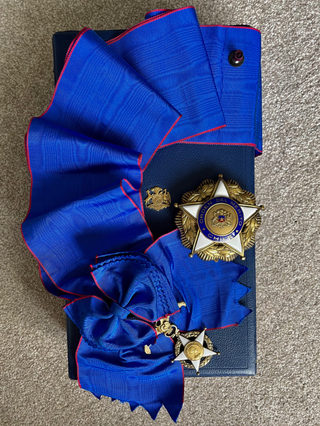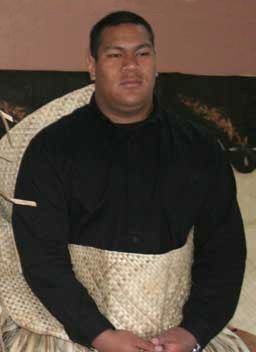
The Most Honourable Order of the Bath is a British order of chivalry founded by King George I on 18 May 1725. The name derives from the elaborate medieval ceremony for appointing a knight, of which bathing was an element. Knights so created were known as "Knights of the Bath". George I constituted the Knights of the Bath a regular "Military Order". He did not revive the Order of the Bath, which had not previously existed as an Order, in the sense of a body of knights governed by a set of statutes and whose numbers were replenished when vacancies occurred.

The Order of Merit of the Federal Republic of Germany is the only federal decoration of Germany. It is awarded for special achievements in political, economic, cultural, intellectual or honorary fields. It was created by the first President of the Federal Republic of Germany, Theodor Heuss, on 7 September 1951. Colloquially, the decorations of the different classes of the Order are also known as the Federal Cross of Merit.
The kailao is a cultural dance from the South Pacific country of Tonga. It originates from Wallis and Futuna.

The Royal Order of Kamehameha I is an order of knighthood established by Kamehameha V in 1865, to promote and defend the sovereignty of the Kingdom of Hawaiʻi. Established by the 1864 Constitution, the Order of Kamehameha I is the second order of its kind in Hawaii.

The Order of the White Eagle is the highest order of merit of the Republic of Poland and one of the oldest distinctions in the world still in use. It was officially instituted on 1 November 1705 by Augustus II the Strong, King of Poland and Elector of Saxony, and bestowed on eight of his closest diplomatic and political supporters. It has since been awarded to the most distinguished Poles for their merits and to the highest-ranking representatives of foreign countries.

The Order of the Dannebrog is a Danish order of chivalry instituted in 1671 by Christian V. Until 1808, membership in the Order was limited to fifty members of noble or royal rank, who formed a single class known as White Knights to distinguish them from the Blue Knights who were members of the Order of the Elephant. In 1808, the Order was reformed and divided into four classes. The statute of the Order was amended in 1951 by a Royal Ordinance so that both men and women could be members of the Order. Today, the Order of the Dannebrog is a means of honouring and rewarding the faithful servants of the modern Danish state for meritorious civil or military service, for a particular contribution to the arts, sciences or business life, or for working for Danish interests.

The Order of Orange-Nassau is a civil and military Dutch order of chivalry founded on 4 April 1892 by the queen regent, Emma of the Netherlands.

The Royal Norwegian Order of Saint Olav is a Norwegian order of chivalry instituted by King Oscar I on 21 August 1847. It is named after King Olav II, known to posterity as St. Olav.

The Order of Civil and Military Merit of Adolph of Nassau is an order of merit of the Grand Duchy of Luxembourg for meritorious service to the Grand Duke, the Grand-Ducal House and Luxembourg. It was founded in 1858 as a chivalric order of the Duchy of Nassau by Adolphe of Nassau in honor of his namesake and ancestor, Adolf, Count of Nassau, the only member of the House of Nassau to have been Roman King of Germany. After the Duchy of Nassau was annexed by Prussia in 1866 and Adolphe became Grand Duke of Luxembourg in 1890, he revived the order as an order of merit.

The Royal Military Order of Saint George for the Defense of the Faith and the Immaculate Conception, also known as the Royal Bavarian House Equestrian Order of Saint George, was founded by Maximilian II Emanuel, Elector of Bavaria in 1729 to provide for a means of honouring the nobility and recognizing distinguished civil and military service.

The Order of Honour is an order of Greece. It comes second in rank to the Order of the Redeemer, and was established in 1975, replacing the abolished Royal Order of George I.

The Royal Order of the Polar Star is a Swedish order of chivalry created by King Frederick I on 23 February 1748, together with the Order of the Sword and the Order of the Seraphim. The Order of the Polar Star is intended as a reward for Swedish and foreign "civic merits, for devotion to duty, for science, literary, learned and useful works and for new and beneficial institutions".
The Order of the African Star was established by Leopold II of Belgium on 30 December 1888, in his capacity as ruler of the Congo Free State, and was awarded for services to Congo and for the "promotion of African civilisation in general". It was incorporated into the Belgian honours system on 10 October 1908 following the annexation of the Congo Free State by Belgium. The motto of the Order is "Travail et progrès". The King of the Belgians is its Grand Master; although the Congo is no longer a Belgian colony, it is still considered to be a Belgian Order by tradition.

The Order of Merit is a Chilean order and was created in 1929. Succeeding the Medal of the Merit, which was created during the term of the President Germán Riesco through the Minister of War decree No. 1350 on 4 September 1906. This new national distinction was created to recognize the meritorious service provided by foreign military personnel to Chilean officials. The order is only awarded to foreigners.

The Royal Order of the Crown of Tonga is an Order of Merit awarded for exceptional services to Tonga and the Crown of Tonga.
The Royal Order of King George Tupou I is a knighthood order of the Kingdom of Tonga.

The Most Illustrious Order of Queen Sālote Tupou III is a knighthood order of the Kingdom of Tonga.
The Royal Military Order of St George is a military knighthood order of the Kingdom of Tonga.

Prince Ata is a Tongan royal and Prince of Tonga, younger son of Tupou VI, King of Tonga.















